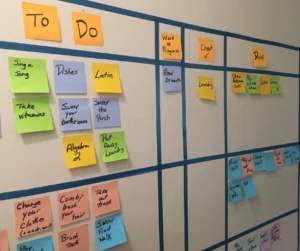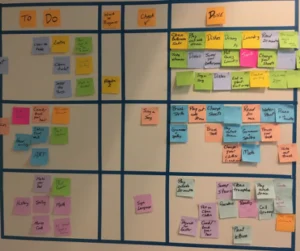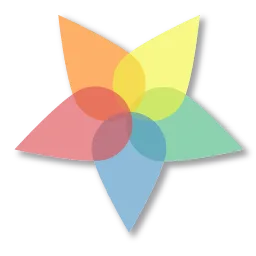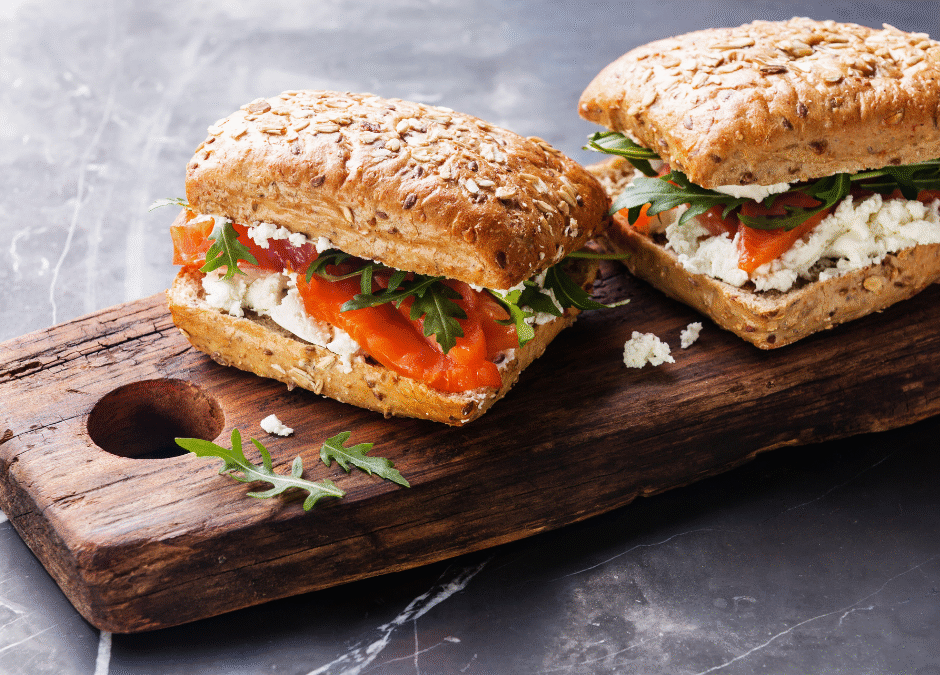Last week, I decided, again, that I needed a new way to tell the kids to do their chores. I was so desperate, that I told my husband, an Industrial Engineer, he could help. I haven’t let him engineer the kids since he tried to “maximize diaper efficiency” which resulted in our firstborn getting diaper rash. But it felt like time to do something different. He thought a kanban board might help, so we gave it a try.
What is Kanban?
 A kanban board is essentially a way to track tasks or projects through the stages of Needs Done, Doing, and Finished. It is used in many businesses. Online tools, like Trello, help businesses track all kinds of things, and literal, physical boards are in many factories. There are a lot of ways to use them for business. But for our kids, we went with a fairly basic setup.
A kanban board is essentially a way to track tasks or projects through the stages of Needs Done, Doing, and Finished. It is used in many businesses. Online tools, like Trello, help businesses track all kinds of things, and literal, physical boards are in many factories. There are a lot of ways to use them for business. But for our kids, we went with a fairly basic setup.
We used washi tape to make a huge grid on the wall between the kids’ rooms and the kitchen. It has 4 columns: To Do, Work in Progress, Checkoff, and Done. There are 3 rows, one for each child. Each child is assigned 3 colors of sticky notes because bright colors make the whole system more engaging and more likely to be used. Of course, the kids got to pick from a stack which colors they wanted.
Why Kanban?
My kids are now 10, 12, and 17. They can read and have had to do chores around the house for years. Sticky notes tell the kids what tasks I want them to do that day, and they move them along through the chart up to the Checkpoint, where I make sure it has been done right. The sticky notes for each day can be new and different, which keeps the Kanban system interesting. One problem I had with past chore charts is that they usually became repetitive, with the same tasks day after day that the kids got bored with. By using several colors of sticky notes, and planning ahead, I can give each child new tasks each day, assuming they did the ones from the day before.
Kanban-style boards are often used to break down a work task into smaller tasks, and that is also helpful for my kids. Instead of a single assignment “Clean the bathroom, ” which can be overwhelming to a kid, I can break it down for them into smaller tasks. One day each week, you might get a bathroom cleaning task. Today, you can clean the sink, tomorrow the floor, and later in the week the bathtub and toilet can be done on separate days. By having one child do all those tasks this week, they figure out how to pace themselves with a bigger task that they don’t really want to do. By showing the kids how a big task can be broken down into smaller tasks, I’m helping them learn skills for life.
I also like that this system gives me the freedom to assign new, untested skills. For example, asking kids who aren’t very good at sweeping the kitchen to sweep the front walkway or the porch will help them learn those skills. Telling my child they have to learn how to sweep something sounds boring. Putting up a sticky that suggests they sweep outside for a change, seems more interesting.
How does this actually work?
 Each morning, I put about 9 sticky notes in each child’s To-Do column. I’ve divided tasks into three main categories: Self-care, School Work, and Household Chore. Each child is assigned about 3 tasks from each category. Each child has three different colors so they can tell which cards are theirs and which cards go with each category.
Each morning, I put about 9 sticky notes in each child’s To-Do column. I’ve divided tasks into three main categories: Self-care, School Work, and Household Chore. Each child is assigned about 3 tasks from each category. Each child has three different colors so they can tell which cards are theirs and which cards go with each category.
For example, Child A has cards in yellow, green, and blue. The 3 green cards each have one self-care activity on them. Each child has self-care items specific to them. The child who forgets to brush their teeth gets that assigned as a card. The oldest gets reminded to take vitamins. Self-care could be taking care of yourself in many ways from showering to going outside to play for 20 minutes. Once the task is done, the child can move the card to “Check” where I initial the cards and move them to the Done section.
The 3 blue post-it notes, each say a chore. For all cards, the child moves it to “Work in Progress” while they are doing it. There are several advantages of having a card up as “in progress.” First off, if a child is reading for 20 minutes, or playing outside as assigned, I can see easily on the board that I don’t need to ask them what they are doing. Also, if my teen moves a card marked “Laundry” to WIP, walking by the card again is a reminder to go move that laundry to the dryer, and then to take it back to their room. If the card lingers there, it is easy for me to ask about it, before the clothes mildew in the washer. For the easily distracted child, these cards can be both reminders and help with staying on task.
Our WIP section is small, and we have told the kids to focus on doing just one thing at a time and do it well. The goal is to get the task all the way to done, not to start everything and finish nothing. The child does the chore and moves it to “Check” where I can inspect their work. This gives me a chance to tell the child that the chore wasn’t done right, and to finish what they started. Sometimes, kids actually need help to figure out what else they need to do, so this is a way to ask for help. “Is it done? I’m not sure, I’ll ask Mom to check it.”
I also give 3 yellow post-it notes for a school subject to do for the day. I’ve decided for now, that this is a good way to rotate through our subjects and change up our school routine. Today’s list of 3 subjects might be Math, Spelling, and Grammar. But tomorrow’s 3 cards might say Art, History, and Handwriting. My goal is to do a total of 15 school blocks each week, so if a child needs a day off, or just skips one, they can do extras on another day.
Rewards
Rewards are an important part of a working chore system. We have decided to tie a weekly allowance to having to complete so many tasks each week. The stack of sticky notes will be added up on Saturday, and kids who need more can work extra hard on the weekend to catch up. I can also state that each kid needs to have so many chores or so many school work post-its in their Done section to get their allowance. Your family could choose to make the reward screen time, tickets to trade for prizes or even just pay a quarter per sticky note completed. It is up to you.
Yes, my kids also get the intrinsic reward of getting to clear their To-Do list and moving it to Done, which is great. However, not everyone finds that motivational. I’m hoping that this system helps them see the value of setting goals for the day and getting them done, but I’m not holding my breath.
Neurodiversity and Challenges
I love this system for kids who have learning challenges because it is very adaptable. For kids who struggle with reading, you can draw pictures on your Post-it notes instead of writing words. Kids who like structure, get it naturally from a board like this. ASD kids often enjoy both knowing what is expected of them for the day, and the process of moving each task down the line as they do it. They have to decide for themselves which task to do first, but with a color-coded system, they can also choose to do all of one color at a time. Starting with all the self-care, then doing chores, then school work gives the day even more structure for them.
For a child with ADHD or executive function disorder, who has trouble remembering what they were supposed to do, moving the Post-it notes, can help them stay on task. For those kids, the ability to choose ANY task to complete next, and do them in their own chosen order, reduces stress. These kids can choose to do the things they like best first or to get the ones they dislike out of the way early. It is up to them.
This system also lets you add things from your child’s sensory diet, like jumping or swinging, to their day, on their own time. The child who needs structure can have the same chores each day if that is what works best. While the child who needs variety can have different chores each day. The flexibility here lets you give all your kids the same system, but use it to meet their individual needs.
What else can it do?
My husband and I also built a kanban for our current project, a garden. The columns make space for “Planning,” “Sprouting inside,” “Outside, ” and “Harvest.” The cards will each list something we want to grow, and those cards will be moved along to show what that plant is doing now. This board will be where the kids can see it, but this is about teaching them how this method could work for them, without explicitly telling them that. One board for the progress of one big project is a great way to keep up with something more complicated than basic chores.
You can build a kanban to track any number of things. I’m hoping that if I demonstrate the idea to them, my kids will be able to take it and run with it later. Many adults have no idea how to keep track of something more complicated than a To-Do list. My goal is to show my kids different ways of organizing thoughts and tasks that they can apply in their own lives.
How is it going?
For now, my kids like the chart and are willing to give it a try. We are tying their allowances to completing so many tasks a week, so that might be improving our rate of compliance. I’ve gotten tired of asking kids to do things over and over, and this seems a great way to stop doing that. I can just ask, did you do all your tasks on the board?
I’m hoping that beyond just doing their chores, they learn how to organize their thoughts, make their own lists, and get things done. That is a useful skill no matter what.





Trying this out with me and my adhd twins (age 10) starting today. The biggest issue I have right now is they often need to be supervised to help them stay on task. So while I’d like to get things done while they are working on something it doesn’t seem possible yet. I think this one might work at least for a while.
Hi Whitney , thanks for commenting!
With my own teenagers , I have definitely put things on the list that they know to do , like take their vitamins or shower. Some days , it really helps them to see what they did get done , and it keeps me from having to nag. I like to have a few of those self care items each day , that they should have no trouble getting done , but it reminds them to take care of themselves. My kids also have a few chores and their school work on their board. I did also write a follow up post on how the Kanban was going after a few weeks , that you may want to read.
https://www.5sensesll.com/index.php/2020/05/07/following-up-on-our-kanban-chore-chart/
Have a great day!
I have been thinking of a similar system and just posted a very simple grid with each child’s name (two) and To do and Done so that they can move their post it to Done after seeing that I have assigned a to-do. Where I am uncertain about expanding on this idea towards your model (which I love) is that I don’t totally want to micromanage them. They are 13 and 15. So I’m wondering if you recommend putting items on that we both know they should do – ie it feels like a 15-year-old should not have a “brush teeth” tab , though I do occasionally nag him to do it.
Can I kanban my partner? 😂
Seriously though , great idea! My only suggestion would be to make sure that the used post-it notes are put into the recycle bin as opposed to being tossed in the trash.